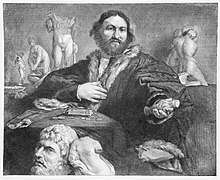Portrait of Andrea Odoni
| Portrait of Andrea Odoni | |
|---|---|
|
| |
| Artist | Lorenzo Lotto |
| Year | 1527 |
| Medium | Oil on canvas |
| Dimensions | 104 cm × 116.6 cm (41 in × 45.9 in) |
| Location | Royal Collection, London |
The Portrait of Andrea Odoni is a painting by the Italian High Renaissance painter Lorenzo Lotto, dating from 1527. It is held in the Royal Collection in Buckingham Palace, London, United Kingdom.
History
The work is mentioned in 1532 by Marcantonio Michiel as part of the collection of Andrea Odoni. It was also seen by the 16th century art biographer Giorgio Vasari. It entered the English royal collection in 1660, having been bought at Amsterdam. In the past it has also been attributed to Titian and Correggio.
The style is typical of Lotto's Venetian period, with denser tones, a softer chromatic range and atmospheric effects at the boundaries.
Description
The horizontal format, with which Lotto had already experimented for portraits of couples, was adopted here for a single subject, a Humanist portrayed among his collection of marbles from Classical antiquity. It has been suggested that the pieces shown here were not real but, more likely, symbols chosen to illustrate the nature and the virtues of Odoni's collection.[1]
The man wears a rich, dark, fur-lined jacket. He sits next to a table, on which there lies a book and some ancient coins. In his hand he holds a small statue, possibly of Diana of Ephesus. The other hand touching the heart is a gesture characteristic of Lotto's work.
Provenance

According to the Royal Collection archives, the painting was in the possession of Andrea Odoni, then his brother, Alvise Odoni, by 1555. It later passed to Lucas van Uffelen, probably by 1623, then Gerrit Reynst, 1639, then the States of Holland and West Friesland for presentation to Charles II as part of the Dutch Gift, 1660.[1] When the painting was in Amsterdam, in the Van Uffelen collection (Van Uffelen returned to live there in 1630) or in the Reynst Collection, it was engraved, in reverse like most engravings of that period, by Cornelis Visscher.
See also
Sources
- 1 2 Andrea Odoni on the website of the Royal Collection
- Pirovano, Carlo (2002). Lotto. Milan: Electa.